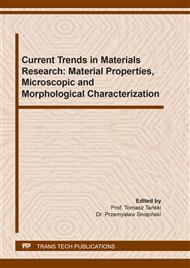[1]
D.S. Mackenzie, Handbook of Aluminum, (2003).
Google Scholar
[2]
F. Aftalion, A history of the International Chemical Industry –Second Editon, Chemical Heritage Press, Philadelphia, (2001).
Google Scholar
[3]
Pakieła W., Tański T., Brytan Z., Labisz K. The influence of laser alloying on the structure and mechanicalproperties of AlMg5Si2Mn surface layers, Appl. Phys. A (2016) 122:352, DOI 10.1007/s00339-016-9834-z.
DOI: 10.1007/s00339-016-9834-z
Google Scholar
[4]
Tański T., Pakieła W., Janicki D., Tomiczek B., Król M. Properties of the aluminium alloy EN AC-51100 after laser surface treatment, Arch. Metall. Mater., Vol. 61 (2016), No 1, p.199–204,.
DOI: 10.1515/amm-2016-0035
Google Scholar
[5]
Brytan Z., Dobrzański L.A., Pakiełą W. Laser surface alloying of sintered stainless steels with SiC powder, Journal of Achievements in Materials and Manufacturing Engineering, V47 I1, 2011, pp.42-56.
Google Scholar
[6]
Pakieła W., Dobrzański L.A., Labisz K., Tański T., Basa K., Roszak M., The effect of laser Surface treatment on structure and mechanical properties aluminium alloy ENAC-AlMg9, Arch. Metall. Mater., Vol. 61 (2016), No 3, p.1343–1350.
DOI: 10.1515/amm-2016-0221
Google Scholar
[7]
Król M., Snopiński P., Tomiczek B., Tański T., Pakieła W. amd Sitek W. Structure and properties of an Al alloy in as-cast state and after laser treatment, Proceedings of the Estonian Academy of Sciences, 2016, 65, 2, 107–116.
DOI: 10.3176/proc.2016.2.07
Google Scholar
[8]
K. E. Oczoś, A. Kawalec: Kształtowanie metali lekkich. Wyd. Naukowe PWN, Warszawa (2012).
Google Scholar
[9]
S. J. Skrzypek, K. Przybyłowicz: Inżynieria metali i ich stopów. Wydawnictwo AGH, Kraków (2012).
Google Scholar
[10]
E. Wojtkun, J.P. Sołoncew: Materiały specjalnego przeznaczenia. Wydawnictwo Politechniki Radomskiej, Radom (2001).
Google Scholar
[11]
A. Fomin, Functionally graded zirconium oxide coatings produced on zirconium using induction heat treatment, Composite Structures, 220,2019, pp.318-323. https://doi.org/10.1016/ j.compstruct.2019.04.001.
DOI: 10.1016/j.compstruct.2019.04.001
Google Scholar
[12]
S.T. Aruna, B. Arul Paligan, N. Balaji, V. Praveen Kumar, Properties of plasma sprayed yttria stabilized zirconia thermal barrier coating prepared from co-precipitation synthesized powder, Ceramics International, 40,7, part B, 2014, pp.11157-11162/ https://doi.org/10.1016/j.ceramint.2014.03.143.
DOI: 10.1016/j.ceramint.2014.03.143
Google Scholar
[13]
H. Chen, Y. Zhang, C. Ding, Tribological properties of nanostructured zirconia coatings deposited by plasma spraying, Wear, 7-8, 253, 2002, pp.885-893. https://doi.org/10.1016/S0043-1648(02)00221-1.
DOI: 10.1016/s0043-1648(02)00221-1
Google Scholar
[14]
Y. Zeng, S.W. Lee, L.Gao. C.X. Ding, Atmospheric plasma sprayed coatings of nanostructured zirconia, Journal of the European Ceramic Society, I3, V22, 2003, pp.347-351. https://doi.org/10.1016/S0955-2219(01)00291-6.
DOI: 10.1016/s0955-2219(01)00291-6
Google Scholar
[15]
M. Afshari, R. Abbasi, M.R. Sovizi, Evaluation of nanometer-sized zirconium oxide incorporated Al-Mg-Ga-Sd alloy as anode for alkaline aluminium batteries, Transaction of Nonferrous Metals Society of China 30,1, 2020, pp.90-98. https://doi.org/10.1016/S1003-6326(19)65182-4.
DOI: 10.1016/s1003-6326(19)65182-4
Google Scholar
[16]
C. Schriwer, A. Skjodl, N.R. Gjerdet, M. Øilo, Monolithic zirconia dental crowns. Internal fit, margin quality, fracture mode and load at fracture, Denatl Materials, 9,33,2017 pp.1012-1020 https://doi.org/10.1016/j.dental.2017.06.009.
DOI: 10.1016/j.dental.2017.06.009
Google Scholar
[17]
Mierzwińska-Nastalska E: Uzupełnienia ceramiczne, postępowanie kliniczne i wykonawstwo laboratoryjne. Med Tour Press International, Otwock (2011).
Google Scholar
[18]
K. Kubicka, T. Godlewski. The use of full-contour zirconia restorations in prosthodontics treatment. Nowa Stomatol 2016; 21 (4), pp.247-252.
Google Scholar
[19]
M. Krupiński, P.E. Smolarczyk and M. Bonek, Microstructure and properties of the copper alloyed with Ag and Ti powders using fiber laser, Materials 2020, 13 (11), 2430. https://doi.org/10.3390/ma13112430.
DOI: 10.3390/ma13112430
Google Scholar
[20]
Syarifudin M., Hale E.N., Sofyan B.T. Effect of ZrO2 Addition on Mechanical Properties and Microstructure of Al-9Zn-6Mg-3Si Matrix Composites Manufactured by Squeeze Casting, IOP Conf. Series: Materials Science and Engineering 517 (2019) 012001,.
DOI: 10.1088/1757-899x/517/1/012001
Google Scholar


